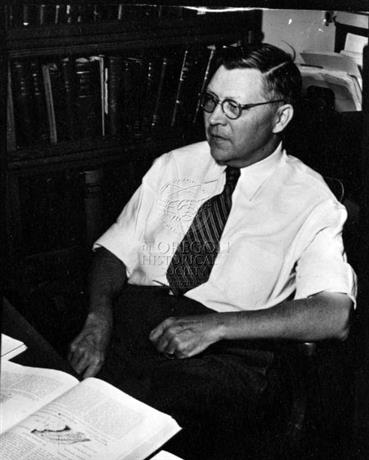During the formative years of neuroanatomy in the first half of the twentieth century, Olof Larsell was instrumental in developing a coherent nomenclature for the cerebellum that would be adopted worldwide. His research laid the groundwork for modern advances in cerebellar anatomy and established Portland as a center of anatomical research.
Larsell was born in Rättvik, Sweden, in 1886 and moved with his family to the United States in 1891. He obtained his bachelor’s degree in biology from McMinnville College (now Linfield College) in 1910 and worked as an instructor there for three years. After meeting zoologist William A. Locy while working at the Friday Harbor Station in Washington, Larsell completed a doctorate under Locy’s direction at Northwestern University. During the summers of 1913 and 1914, he worked with C. Judson Herrick, a neurologist at the University of Chicago, who encouraged Larsell to focus his research on comparative neurology, particularly cerebellar anatomy. Larsell’s thesis, completed in 1918, elucidated the structure of the nervus terminalis in mammals.
Larsell was appointed assistant professor of anatomy at the University of Wisconsin in 1918, where he continued his research in comparative anatomy. His first paper on the cerebellum of ambystoma was the beginning of a series of studies that made him one of the world’s authorities on the anatomy and function of the outgrowth of the rhombencephalon, or hindbrain, of the central nervous system.
In 1921, Larsell met with Richard Dillehunt, dean of the University of Oregon Medical School (UOMS) , and he soon relocated to Portland to join the UOMS faculty as professor of anatomy. It was a position he would hold until his state-mandated retirement in 1952, at the age of sixty-five.
During his tenure at University of Oregon, Larsell continued his foundational work on neuroanatomy. In addition to writing numerous articles and monographs, he wrote the section on the nervous system for the tenth edition of Morris’ Human Anatomy (1942), which also included many original plates and figures drawn under his supervision by Clarice Ashworth Francone, the university’s accomplished medical illustrator.
In 1923, Larsell formed a Medical History Club for faculty and student assistants at the medical school. At its monthly meetings—often held at the Larsell home—members presented papers on topics ranging from the physical diagnosis of the cardiovascular system to the history of medicine in Jackson County. Much of the record of the history of medicine in the Pacific Northwest was preserved through his efforts. He interviewed many people and encouraged others to do likewise. His work on the history of medicine in Oregon culminated in the publication of The Doctor in Oregon in 1947; it remains the most comprehensive work on Oregon medicine ever produced.
After retiring from UOMS, Larsell spent two years as professor of neuroanatomy at the University of Minnesota before returning to Portland to resume his research at Good Samaritan Hospital. His first paper on the cerebellum was published in 1923; at the time of his death in 1964, he was completing the last chapter of his definitive, three-volume monograph on The Comparative Anatomy and Histology of the Cerebellum (published posthumously in 1967).
-
![]()
Olof Larsell, professor of anatomy at the University of Oregon Medical School.
Courtesy Oregon Health & Sciences University Historical Collections and Archives, Digital Collections
-
![]()
Dr. Olof Larsell, professor of Anatomy at University of Oregon Medical School, 1948.
Oregon Historical Society Research Library, Oregon Journal Collection, 012150
Related Entries
-
![Linfield University]()
Linfield University
Linfield University received its charter from the Oregon Territorial Le…
-
![Robert Stone Dow (1908-1995)]()
Robert Stone Dow (1908-1995)
Pioneering neuroscientist Robert Stone Dow was Oregon’s first board-cer…
Map This on the Oregon History WayFinder
The Oregon History Wayfinder is an interactive map that identifies significant places, people, and events in Oregon history.
Further Reading
"In Memoriam: Olof Larsell, 1886-1964." Journal of comparative neurology 123:1-4 (1964).
Jones, Arthur C. "Olof Larsell, M.A., Ph.D., Sc.D." In: Proceedings of the annual meeting of the Alumni Association, Medical School, University of Oregon. Portland, Ore.: The Association, 1942, p. 5.




